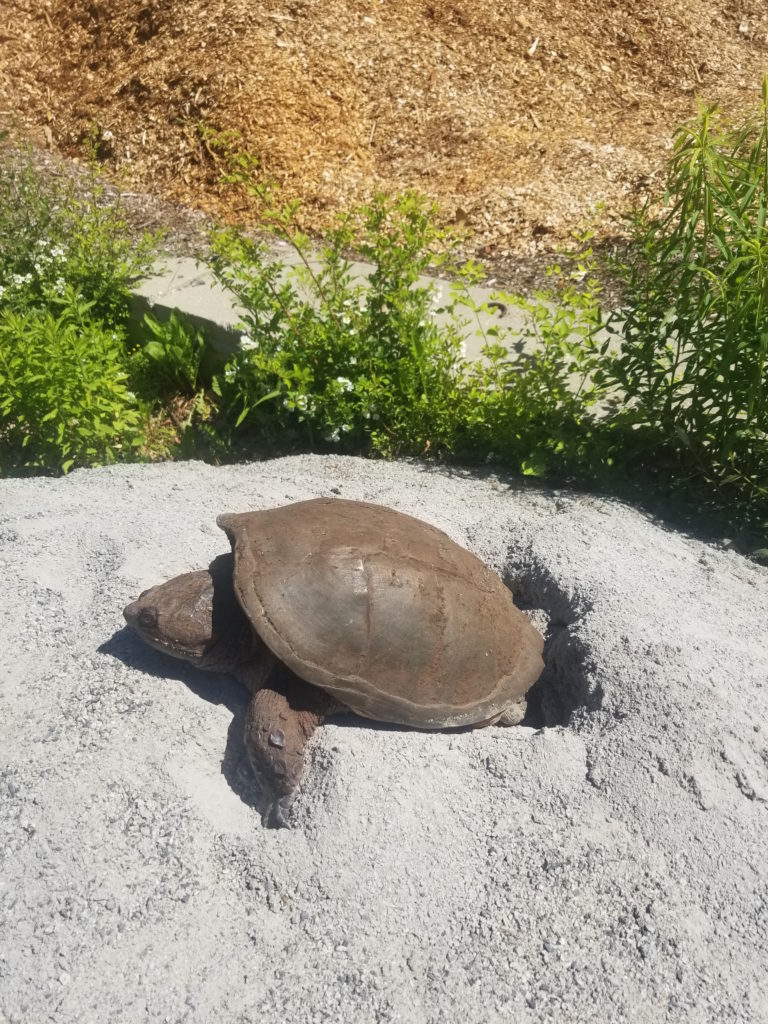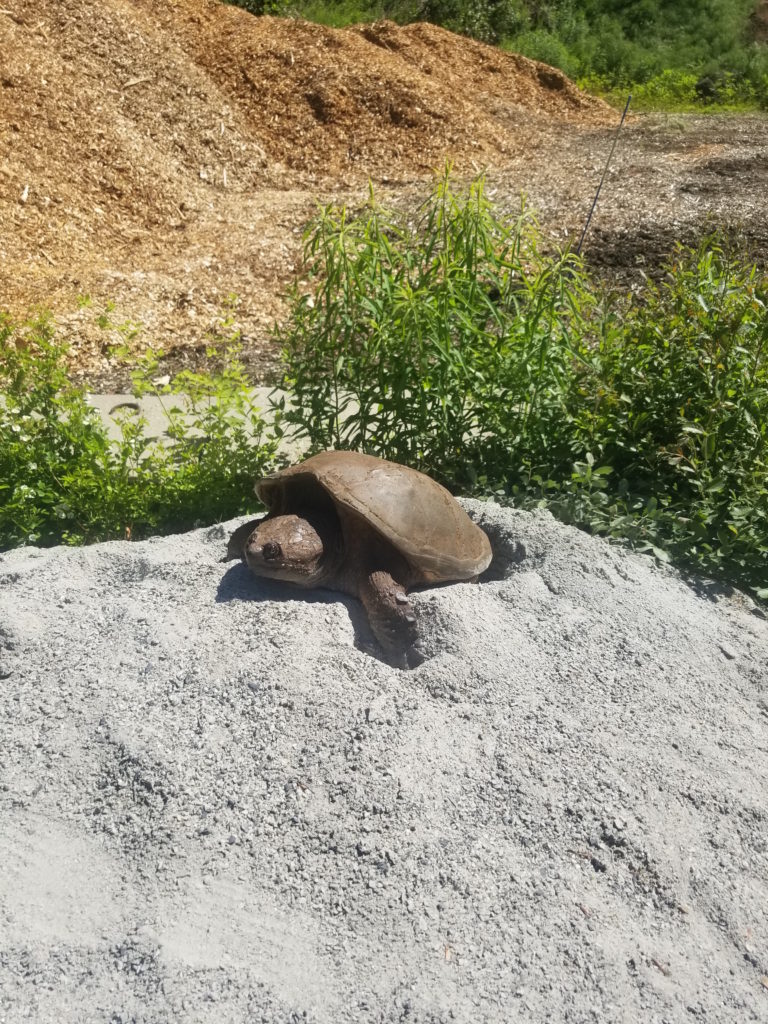 One recent Sunday morning before church, I was surprised by a call on the house phone. “Dr. B?” someone asked. “This is N, from environmental science. I’m here with A. We are walking out near Gull pond. I’m sorry to bother you, but we found a turtle. We think it might be stuck. The turtle is on a gravel hill and its moving its legs and not going forward. Should we help it move?”
One recent Sunday morning before church, I was surprised by a call on the house phone. “Dr. B?” someone asked. “This is N, from environmental science. I’m here with A. We are walking out near Gull pond. I’m sorry to bother you, but we found a turtle. We think it might be stuck. The turtle is on a gravel hill and its moving its legs and not going forward. Should we help it move?”
I explained that it was very unlikely that the turtle was stuck. Turtles have been going over gravel bumps for a long time. I asked if it looked like the turtle was digging. They could not tell. I asked what the shell looked like. Together we could not get much farther over the phone although I had a pretty good idea what was going on.
I asked the students to take some pictures and send me some pictures. Later in the afternoon, I got to look at the photos. As I suspected, the turtle was fine. It was a female digging a hole to lay eggs. She would then go back to her pond home and the eggs, covered with sand and gravel, will develop over a period of 75 to 95 days. When they hatch from the leathery shells, the baby turtles will push their way through the dust and dirt to the surface and walk by instinct to the pond as well. Around here, that often means crossing a road. Watch for the mamas on the way to lay eggs, and the babies on the way back!
From the students’ descriptions, I thought it was most likely a snapping turtle. However, it did not have some of the ridges some snappers have and I wasn’t certain from just hearing about it. Nonetheless, when I saw the stout head and gripping jaws, and powerful digging legs, I knew it was the common snapping turtle, Chelydra serpentina.
How else might I have figured this out? Well, there are only ten (actually , eleven, but we’ll come to that) species of turtles in Massachusetts (and up to five sea turtle species that could -potentially- be seen in the waters near Cape Cod). Of the ten land/pond/wetland species, most are quite rare. Blanding’s Turtle, the Bog Turtle, the Eastern Box Turtle, the Diamond-backed Terrapin, the Northern Red-bellied Cooter, and the Wood Turtle are all so rare that it is illegal to kill, harass, collect or possess them. If you get into herpetology enough and can find one of these and recognize it, take a picture and tell the Massachusetts National Heritage and Endangered Species Program.
Then there are the Spotted Turtle (which has spots, not surprisingly) and the Eastern Musk Turtle, (which lets out a terrible odor when frightened). Neither of these look like our turtle and neither are very common in this area or big enough to to be this mama.
There are three species left:
The Painted turtle is quite common, but it is small, has a very smooth shell and distinctive yellow lines and spots on its head.
Aha- Now we come to the reason some lists say ten and some say eleven species of turtles in Massachusetts: the Red-eared Slider is quite common in this area but it is not a native to the northeast. Instead, it has been released here and many other parts of the world by people who got tired of their pets and released them into the wild where they bred. Releasing pets is actually a very bad idea. (Similar releasing of the African Clawed frog caused the spread of a deadly fungus across North America that wiped out members of many other frog species.) For the purpose of our question- the Red Eared Slider is also too smooth, too small, and has red spots on its head.
The only one left is the rugged snapper. Built like a tank, and sometimes irascible, snapping turtles have long life spans and get very large. The oldest recorded was one hundred years old, in Canada, and the largest can be 19 inches (almost half a meter) long. Females don’t even reach reproductive age until 15-20 years old! Snapping Turtles are omnivores, eating plants as well as fish, frogs, snakes, birds, insects, and smaller turtles as well as scavenging. When turtle soup was a more common food, the turtle in the soup was usually Snapping Turtle.

photo credit: Nathan Lookwhy
Back to our lovely , hopeful mama turtle. Should all go well, and predators such as raccoons or weasels not find and eat the eggs, those babies will hatch. Whether they become male or female will depend on the temperature at which they incubate. The higher temperatures produce more females. You can imagine that warming temperatures are changing turtle sex ratios. In fact, among sea turtles some, like the Green Sea Turtle in Australian waters, are 99% female. Hopefully, here in the temperate forest, we will still see a mixture of sexes in the babies that hatch.
Just a few more tidbits about Snapping Turtles:
- You cannot pick them up by the tail safely. That’s an old wives tale. They are very likely to be injured. You can break the tail or even part of the back.
- unless they are small or you are very experienced, it is probably better not to pick up a Snapping Turtle. There are all sorts of videos on You tube claiming to know how but since some of them show people picking up turtles by the tail- you can’t necessarily trust the. If a Snapping Turtle is medium or large and in danger- try to nudge it in the direction it was going with a stick.
- Like all turtles, the shell of a Snapping Turtle has two parts- the top carapace and the bottom plastron. The carapace is made from about 50 bones fused together- the ribs and vertebrae. So in spite of many cartoons to the contrary, turtles cannot leave their shells!
- Turtles have a territory and if you move them elsewhere they won’t know what to do and they will try to return home, even if that is dangerous.
- In general, enjoy seeing them and then let them be.
Thanks for learning a little about Snapping Turtles with me! Here are some resources:
https://massherpatlas.org/amphibians_reptiles/turtles/snapping_turtle/index.html
